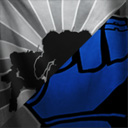 Xenroth, on 28 June 2013 - 04:15 AM, said:
Xenroth, on 28 June 2013 - 04:15 AM, said:
I would do it like that,
Tiny: 20-25 Tons, so any Mech below 30 tons
SlowdownAngle: 40°
Small: Any Mech between 30-45 tons
SlowdownAngle: 35°
Medium: Any Mech between 50-60 tons
SlowdownAngle: 30°
Large: Any Mech between 65-80 tons
SlowdownAngle: 25°
Huge: Any Mech with 85+ tons (85-100)
SlowdownAngle: 20°
Here's how I figured it worked.
Jenner (35 tons) vs Raven (35 tons)
Why is the Jenner Tiny and the Raven (and cicada) small? Both have the same size and profile, but...
Chicken legs.
Think about it. When moving forward, a Jenner with regular legs is bringing its foot behind the mech then moving it up and forward. The chicken legged Cicada and Raven, however, are moving their legs simply up and forward (without moving it behind them first) which, theoretically, would give the Jenner more leg clearance on steeper slopes.
Catapract v 'Pult v Jager v Quickdraw
This ones pretty difficult, but it includes 2 factos:
1) Chicken Legs
2) Mech profile
The 'Phract and 'Pult both have chicken legs. However, the 'Phract is a hunchy profile, arms hanging low to the ground, which would place its center-of-gravity lower as well. By contrast, a 'Pult has two hulking weapons pods
above its cockpit, throwing its center higher. Though 10 tons more, the 'Phract would likely have an easier time climbing a slightly higher slope then the higher center-of-gravity 'Pult, who's a bit more top-heavy and likely to slip or fall backwards.
Jager v Quickdraw
Again, all about profile and balance. Look at the Quickdraw's large upper torso. Even though its 5 tons less then the Jager, it's upper body is proportionately larger then its legs when comparing it to the Jager. The Jager's boxy design is actually fairly balanced, and would make for a slightly easier time going up hills by comparison (the quickdraw also has JJ's, remember that!)
Finally, the Stalker.
Why not huge? Chicken legs, check. High center of gravity, check.
Again, take a look at its profile. That nose is freaking HUGE.
And a Huge weight at the
front of the mech will make for an easier time
climbing hills, as it'll have a smaller chance of falling backwards vs the upright Atlas. Think about it, the bulk of the weight leaning forward on the mech....yea I think you can understand that.
This has been an episode of Howe's Help Corner. Thank you for reading.
 Haitchpeasauce, on 27 June 2013 - 09:19 PM, said:
Haitchpeasauce, on 27 June 2013 - 09:19 PM, said:

 This topic is locked
This topic is locked

































